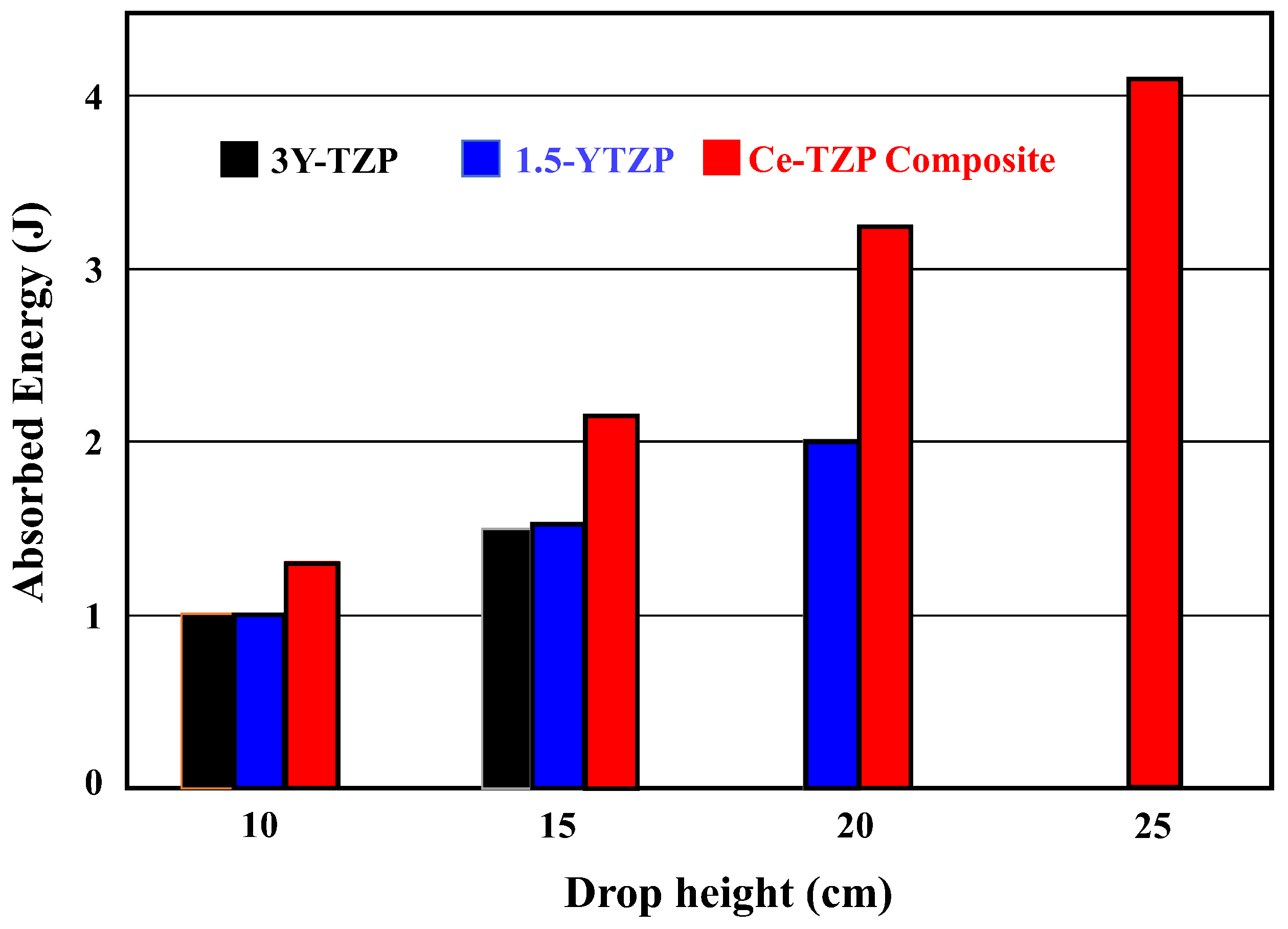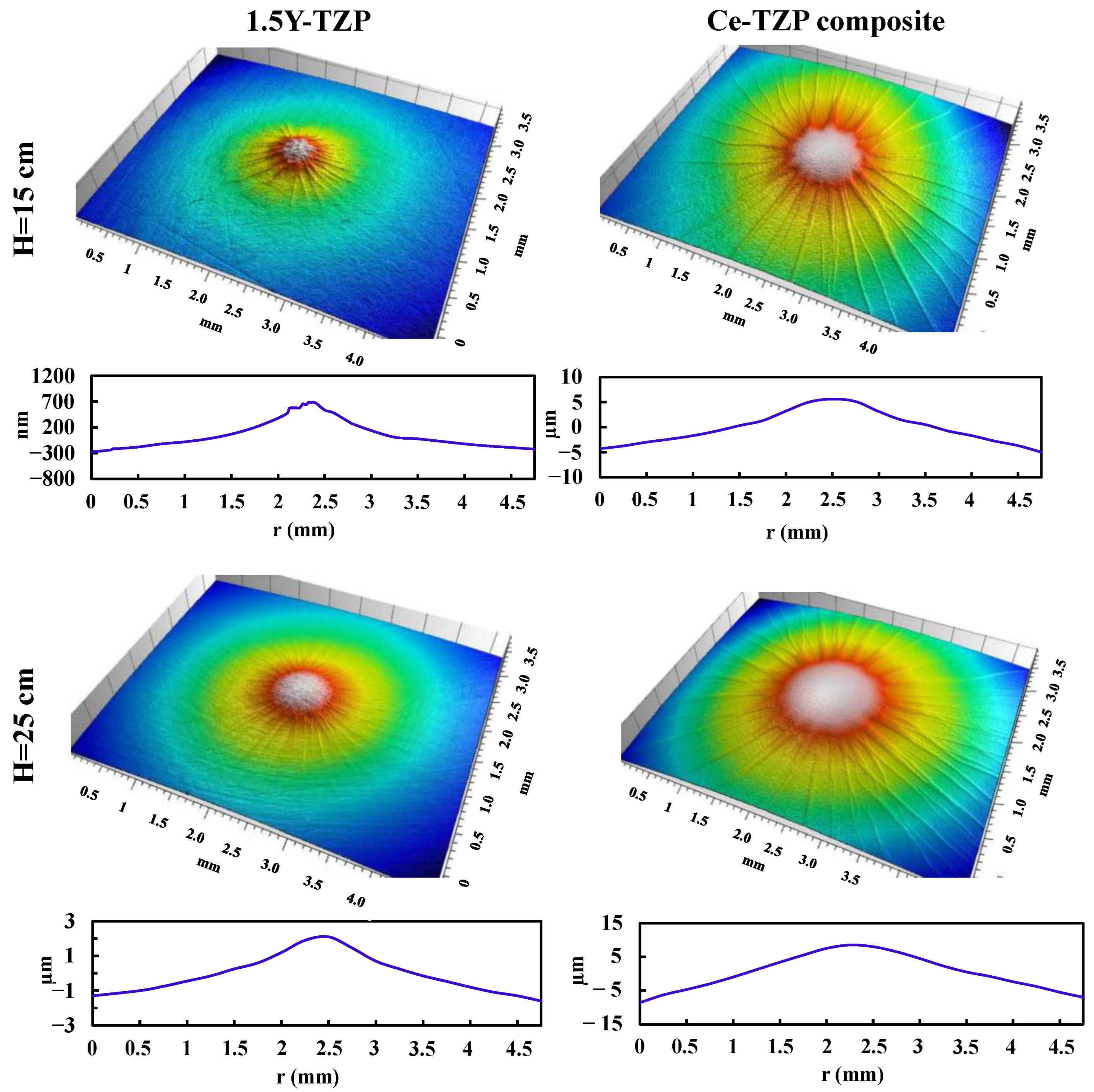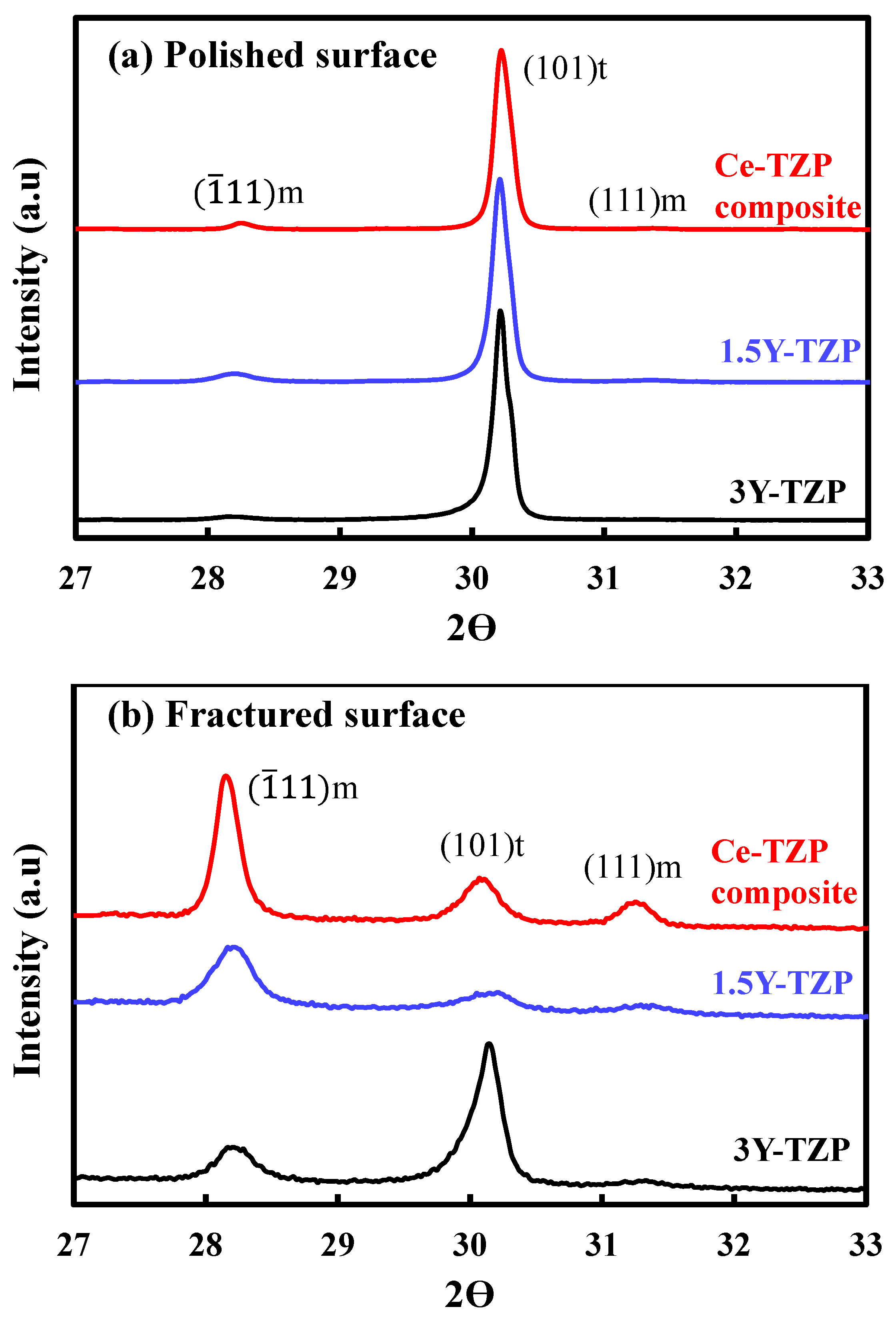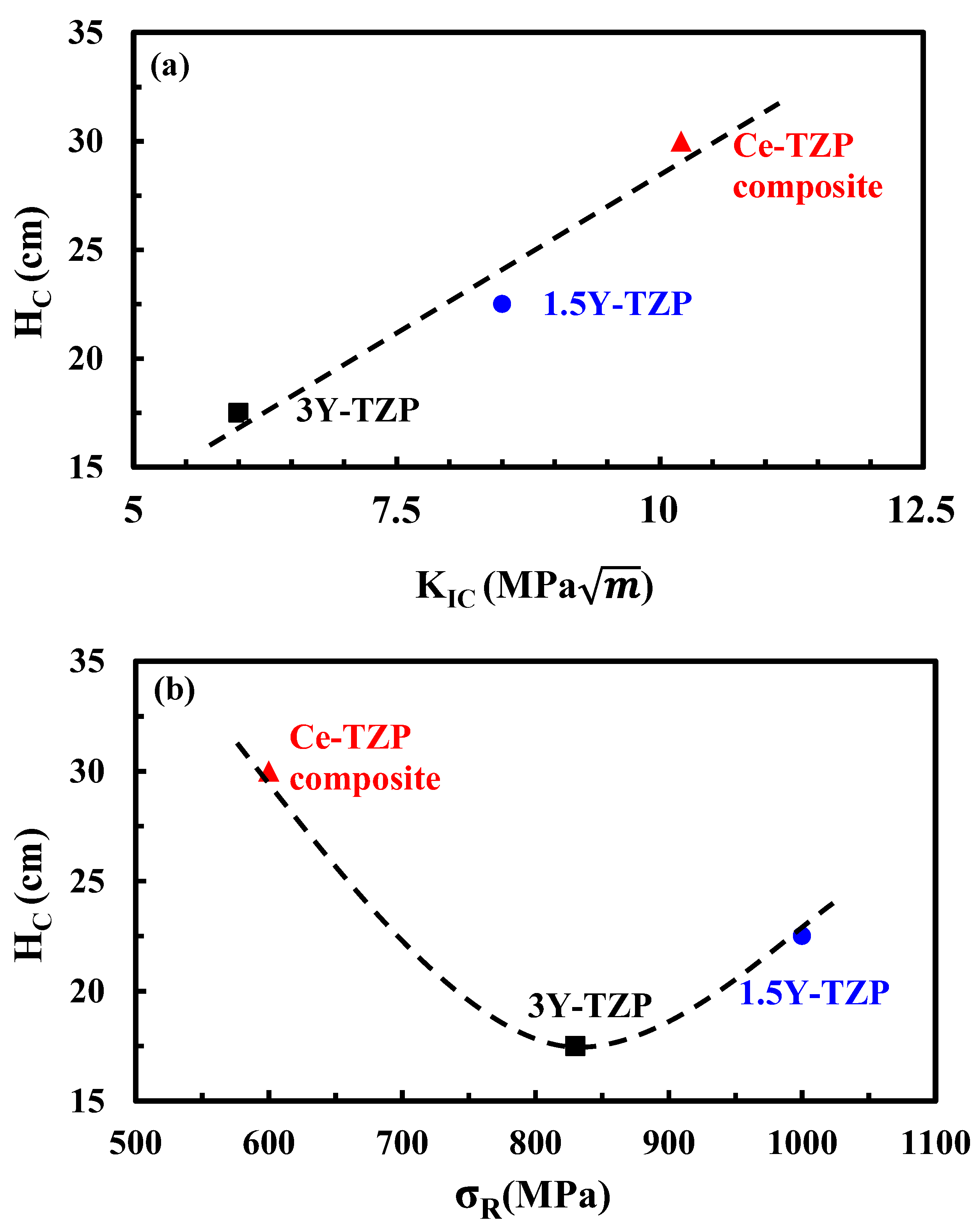Impact Resistance of Yttria- and Ceria-Doped Zirconia Ceramics in Relation to Their Tetragonal-to-Monoclinic Transformation Ability
Abstract
:1. Introduction
2. Materials and Methods
3. Results
3.1. Microstructure and Properties
3.2. Critical Drop Height
3.3. Absorbed Energy
3.4. Impact-Induced Phase Transformation
4. Discussion
5. Conclusions
Author Contributions
Funding
Institutional Review Board Statement
Informed Consent Statement
Data Availability Statement
Conflicts of Interest
References
- Evans, A.G.; Heuer, A.H. Review-Transformation toughening in ceramics: Martensitic transformations in crack-tip stress fields. J. Am. Ceram. Soc. 1980, 63, 241–248. [Google Scholar] [CrossRef]
- Swain, M.V. Inelastic deformation of Mg-PSZ and its significance for the strength-toughness relationship of zirconia-toughened ceramics. Acta Metall. 1985, 33, 2083–2091. [Google Scholar] [CrossRef]
- Hannink, R.; Kelly, P.; Muddle, B. Transformation toughening in ZrO2-containing ceramics. J. Am. Ceram. Soc. 2000, 83, 461–487. [Google Scholar] [CrossRef]
- Al-Amleh, B.; Lyons, K.; Swain, M. Clinical trials in zirconia: A systematic review. J. Oral Rehabil. 2010, 37, 641–652. [Google Scholar] [CrossRef] [PubMed]
- Turon-Vinas, M.; Anglada, M. Fracture toughness of zirconia from a shallow notch produced by ultra-short pulsed laser ablation. J. Eur. Ceram. Soc. 2014, 34, 3865–3870. [Google Scholar] [CrossRef]
- Touaiher, I.; Saâdaoui, M.; Chevalier, J.; Preiss, L.; Reveron, H. Fracture behavior of Ce-TZP/alumina/aluminate composites with different amounts of transformation toughening: Influence of the testing methods. J. Eur. Ceram. Soc. 2018, 38, 1778–1789. [Google Scholar] [CrossRef]
- Tsukuma, K.; Shimada, M. Strength, fracture toughness, and Vickers hardness of CeO2-stabilized tetragonal ZrO2 polycrystals (Ce-TZP). J. Mater. Sci. 1985, 20, 1178–1184. [Google Scholar] [CrossRef]
- El Attaoui, H.; Saâdaoui, M.; Chevalier, J.; Fantozzi, G. Static and cyclic crack propagation in Ce-TZP ceramics with different amounts of transformation toughening. J. Eur. Ceram. Soc. 2007, 27, 483–486. [Google Scholar] [CrossRef]
- Chevalier, J.; Liens, A.; Reveron, H.; Zhang, F.; Reynaud, P.; Douillard, T.; Preiss, L.; Sergo, V.; Lughi, V.; Swain, M.; et al. Forty years after the promise of «ceramic steel?: Zirconia-based composites with a metal-like mechanical behavior. J. Am. Ceram. Soc. 2020, 103, 1482–1513. [Google Scholar] [CrossRef]
- Liens, A.; Reveron, H.; Douillard, T.; Blanchard, N.; Lughi, V.; Sergo, V.; Laquai, R.; Müller, B.R.; Bruno, G.; Schomer, S.; et al. Phase transformation induces plasticity with negligible damage in ceria-stabilized zirconia-based ceramics. Acta Mater. 2020, 183, 261–273. [Google Scholar] [CrossRef]
- Swain, V.; Rose, L. Strength limitations of transformation-toughened zirconia alloys. J. Am. Ceram. Soc. 1986, 69, 511–518. [Google Scholar] [CrossRef]
- Yu, C.S.; Shetty, D.K. Transformation zone shape, size, and crack-growth-resistance [R-curve] behavior of ceria-partially-stabilized zirconia polycrystals. J. Am. Ceram. Soc. 1989, 72, 921–928. [Google Scholar] [CrossRef]
- Sato, T.; Endo, T.; Shimada, M. Hot isostatic pressing of ceria-doped tetragonal zirconia/alumina composites in an argon-oxygen gas atmosphere. J. Am. Ceram. Soc. 1989, 72, 761–764. [Google Scholar] [CrossRef]
- Tsai, J.; Yu, C.; Shetty, D. Fatigue crack propagation in ceria-partially-stabilized zirconia (Ce-TZP)-alumina composites. J. Am. Ceram. Soc. 1990, 73, 2992–3001. [Google Scholar] [CrossRef]
- Yu, C.; Shetty, D. Transformation yielding, plasticity, and crack-growth-resistance (R-curve) behavior of CeO2-TZP. J. Mater. Sci. 1990, 25, 2025–2035. [Google Scholar] [CrossRef]
- Cutler, R.; Mayhew, R.; Prettyman, K.; Virkar, A. High-toughness Ce-TZP/Al2O3 ceramics with improved hardness and strength. J. Am. Ceram. Soc. 1991, 74, 179–186. [Google Scholar] [CrossRef]
- Tsai, J.; Chon, U.; Ramachandran, N.; Shetty, D. Transformation plasticity and toughening in CeO2-partially-stabilized zirconia–alumina (Ce-TZP/Al2O3) composites doped with MnO. J. Am. Ceram. Soc. 1992, 75, 1229–1238. [Google Scholar] [CrossRef]
- Ramachandran, N.; Chao, L.; Shetty, D. R-curve behavior and flaw insensitivity of Ce-TZP/Al2O3 composite. J. Am. Ceram. Soc. 1993, 76, 961–969. [Google Scholar] [CrossRef]
- Readey, M.; McCallen, C. Flaw tolerance and reliability of Ce-TZP and Y-TZP ceramics. J. Am. Ceram. Soc. 1995, 78, 2769–2776. [Google Scholar] [CrossRef]
- Nawa, M.; Nakamoto, S.; Sekino, T.; Niihara, K. Tough and strong Ce-TZP/alumina nanocomposites doped with titania. Ceram. Int. 1998, 24, 497–506. [Google Scholar] [CrossRef]
- Dietrich, M. What can we learn from R-curve measurements? J. Am. Ceram. Soc. 2007, 90, 1–15. [Google Scholar]
- Benzaid, R.; Chevalier, J.; Saâdaoui, M. Fracture toughness, strength, and slow crack growth in a ceria-stabilized zirconia-alumina nanocomposite for medical applications. Biomaterials 2008, 29, 3636–3641. [Google Scholar] [CrossRef] [PubMed]
- Nawa, M.; Kurizoe, N.; Okamoto, Y.; Ueno, A. Transformation-induced plastic deformation in Ce-TZP/alumina nanocomposite generated during fatigue tests at room temperature. J. Eur. Ceram. Soc. 2014, 34, 4337–4345. [Google Scholar] [CrossRef]
- Palmero, P.; Fornabaio, M.; Montanaro, L.; Reveron, H.; Esnouf, C.; Chevalier, J. Towards long-lasting zirconia-based composites for dental implants: Part I: Innovative synthesis, microstructural characterization, and in vitro stability. Biomaterials 2015, 50, 38–46. [Google Scholar] [CrossRef] [PubMed]
- Reveron, H.; Fornabaio, M.; Palmero, P.; Fürderer, T.; Adolfsson, E.; Lughi, V.; Bonifacio, A.; Sergo, V.; Montanaro, L.; Chevalier, J. Towards long-lasting zirconia-based composites for dental implants: Transformation-induced plasticity and its consequence on ceramic reliability. Acta Biomater. 2017, 48, 423–432. [Google Scholar] [CrossRef] [PubMed]
- Hannink, R.H.; Swain, M.V. Metastability of the martensitic transformation in a 12 mol% ceria-zirconia alloy: I, deformation and fracture observations. J. Am. Ceram. Soc. 1989, 72, 90–98. [Google Scholar] [CrossRef]
- Vasylkiv, O.S.; Sakka, Y.; Skorokhod, V.V. Low-temperature processing and mechanical properties of zirconia and zirconia–alumina nanoceramics. J. Am. Ceram. Soc. 2003, 86, 299–304. [Google Scholar] [CrossRef]
- Basu, B. Toughening of yttria-stabilised tetragonal zirconia ceramics. Int. Mater. Rev. 2005, 50, 239–256. [Google Scholar] [CrossRef]
- Trunec, M.; Chlup, Z. Higher fracture toughness of tetragonal zirconia ceramics through nanocrystalline structure. Scr. Mater. 2009, 61, 56–59. [Google Scholar] [CrossRef]
- Cui, J.; Gong, Z.; Lv, M.; Lv, M.; Rao, P. Determination of fracture toughness of Y-TZP ceramics. Ceram. Int. 2017, 43, 16319–16322. [Google Scholar] [CrossRef]
- Matsui, K.; Nakamura, K.; Saito, M.; Kuwabara, A.; Yoshida, H.; Ikuhara, Y. Low-temperature degradation in yttria-stabilized tetragonal zirconia polycrystal: Effect of Y3+ distribution in grain interiors. Acta Mater. 2022, 227, 117659. [Google Scholar] [CrossRef]
- Kern, F.; Osswald, B. Properties of a pressureless sintered 2Y-TZP material combining high strength and toughness. Ceramics 2024, 7, 893–905. [Google Scholar] [CrossRef]
- Zhang, X.F.; Li, Y.C. On the comparison of the ballistic performance of 10% zirconia toughened alumina and 95% alumina ceramic target. Mater. Des. 2010, 31, 1945–1952. [Google Scholar] [CrossRef]
- Savio, S.G.; Madhu, V.; Gogia, A.K. Ballistic performance of alumina and zirconia-toughened alumina against 7.62 armour piercing projectile. Def. Sci. J. 2014, 64, 477–483. [Google Scholar] [CrossRef]
- Huang, C.Y.; Chen, Y.L. Design and impact resistant analysis of functionally graded Al2O3–ZrO2 ceramic composite. Mater. Des. 2016, 91, 294–305. [Google Scholar] [CrossRef]
- Huang, C.Y.; Chen, Y.L. Effect of varied alumina/zirconia content on ballistic performance of a functionally graded material. Int. J. Refract. Met. Hard Mater. 2017, 67, 129–140. [Google Scholar] [CrossRef]
- Koch, B.M.; Jannotti, P.; Mallick, D.; Schuster, B.; Sano, T.; Hogan, J.D. Influence of microstructure on the impact failure of alumina. Mater. Sci. Eng. A 2020, 770, 138549. [Google Scholar] [CrossRef]
- Wade-Zhu, Y.; Wade-Zhu, J.; Wu, H.; Binner, J.; Vaidhyanathan, B. The ballistic impact performance of nanocrystalline zirconia-toughened alumina (nZTA) and alumina ceramics. J. Eur. Ceram. Soc. 2021, 41, 1427–1437. [Google Scholar] [CrossRef]
- Andraskar, N.D.; Tiwari, G.; Goel, M.D. Impact response of ceramic structures—A review. Ceram. Int. 2022, 48, 27262–27279. [Google Scholar] [CrossRef]
- Umbharatwala, M.D.; Goel, M.D. Experimental, numerical, and analytical prediction of ballistic resistance of indigenously developed zirconia-toughened alumina, Kevlar®, and CFRP composite. Compos. Part B Eng. 2024, 282, 111582. [Google Scholar] [CrossRef]
- Imariouane, M.; Saâdaoui, M.; Denis, G.; Reveron, H.; Chevalier, J. Low-yttria doped zirconia: Bridging the gap between strong and tough ceramics. J. Eur. Ceram. Soc. 2023, 43, 4906–4915. [Google Scholar] [CrossRef]
- ASTM C373-88; Standard Test Method for Water Absorption, Bulk Density, Apparent Porosity, and Apparent Specific Gravity of Fired Whiteware Products. ASTM International: West Conshohocken, PA, USA, 1988.
- Garvie, R.C.; Nicholson, P.S. Phase analysis in zirconia systems. J. Am. Ceram. Soc. 1972, 55, 303–305. [Google Scholar] [CrossRef]
- Toraya, H.; Yoshimura, M.; Somiya, S. Calibration curve for quantitative analysis of the monoclinic-tetragonal ZrO2 system by X-ray diffraction. J. Am. Ceram. Soc. 1984, 67, 1197–2121. [Google Scholar] [CrossRef]
- Lin, J.D.; Duh, J.G. Fracture toughness and hardness of ceria-and yttria-doped tetragonal zirconia ceramics. Mater. Chem. Phys. 2003, 78, 253–261. [Google Scholar] [CrossRef]
- Ćorić, D.; Ćurković, L.; Majić Renjo, M. Statistical analysis of Vickers indentation fracture toughness of Y-TZP ceramics. Trans. FAMENA 2017, 41, 1–16. [Google Scholar] [CrossRef]
- Freitas, B.X.; Duarte, E.T.; Vasconcelos, J.E.A.; Magnago, R.O.; Strecker, K.; Santos, C. Mechanical properties of Ce-TZP/Al2O3 ceramic composites as a function of sintering parameters. Ceramica 2024, 69, 305–311. [Google Scholar]
- Touaiher, I.; Saâdaoui, M.; Chevalier, J.; Reveron, H. Effect of loading configuration on strength values in a highly transformable zirconia-based composite. Dent. Mater. 2016, 32, e211–e219. [Google Scholar] [CrossRef]
- Liens, A. On the Potential of Ti-Based Bulk Metallic Glasses and Ce-TZP Zirconia Composites for the Development of Innovative Dental Implants. Ph.D. Thesis, Institut National des Sciences Appliquées de Lyon, Lyon, France, 2019. [Google Scholar]
- Chevalier, J.; Gremillard, L.; Virkar, A.V.; Clarke, D.R. The tetragonal—monoclinic transformation in zirconia: Lessons learned and future trends. J. Am. Ceram. Soc. 2009, 92, 1901–1920. [Google Scholar] [CrossRef]
- Valot, C.; Ciosmak, D.; Mesnier, M.T.; Lallemant, M. Phase analysis by variable-incidence X-ray diffraction: Application to zirconium oxidation. Oxid. Met. 1997, 48, 329–345. [Google Scholar] [CrossRef]
- Choi, S.R.; Pereira, J.M.; Janosik, L.A.; Bhatt, R.T. Foreign object damage in flexure bars of two gas-turbine grade silicon nitrides. Mater. Sci. Eng. A 2004, 379, 411–419. [Google Scholar] [CrossRef]
- Berthier da Cunha, T.; Wu, J.P.; Peitl, O.; Fokin, V.M.; Zanotto, E.D.; Iannucci, L.; Boccaccini, A.R. Mechanical properties and impact resistance of a new transparent glass-ceramic. Adv. Eng. Mater. 2007, 9, 191–196. [Google Scholar] [CrossRef]
- Guo, Y.N.; Sun, Q.; Wu, L. Study of dynamic impact behaviors and ballistic properties of ceramic/UHMWPE composite armor. Appl. Mech. Mater. 2012, 121, 397–400. [Google Scholar] [CrossRef]
- Huang, C.Y.; Chen, Y.L. Effect of mechanical properties on the ballistic resistance capability of Al2O3-ZrO2 functionally graded materials. Ceram. Int. 2016, 42, 12946–12955. [Google Scholar] [CrossRef]
- Hu, D.; Zhang, Y.; Shen, Z.; Cai, Q. Investigation on the ballistic behavior of mosaic SiC/UHMWPE composite armor systems. Ceram. Int. 2017, 43, 10368–10376. [Google Scholar] [CrossRef]
- Fabris, D.C.N.; Polla, M.B.; Acordi, J.; Luza, A.L.; Bernardin, A.M.; De Noni, A., Jr.; Montedo, O.R.K. Effect of MgO·Al2O3·SiO2 glass-ceramic as a sintering aid on properties of alumina armors. Mater. Sci. Eng. A 2020, 781, 139237. [Google Scholar] [CrossRef]
- Dresch, A.B.; Venturini, J.; Arcaro, S.; Montedo, O.R.; Bergmann, C.P. Ballistic ceramics and analysis of their mechanical properties for armour applications: A review. Ceram. Int. 2021, 47, 8743–8761. [Google Scholar] [CrossRef]
- Touaiher, I. Comportement à la Rupture de Nouveaux Composites Triphasiques à Base de Zircone Ce-TZP Hautement Transformables: Influence des Méthodes D’essais. Ph.D. Thesis, Ecole Mohammadia d’Ingénieurs, Rabat, Morocco, 2018. [Google Scholar]










| Sample | 1.5Y-TZP | 3Y-TZP | Ce-TZP Composite |
|---|---|---|---|
| Density (% TD) | 99.7 | 99.7 | 99.7 |
| Hardness (Hv1) | 1180 | 1305 | 1000 |
| Zirconia grain size (µm ± Sd) | 0.4 ± 0.1 | 0.7 ± 0.1 | 0.9 ± 0.4 |
| Material | HC (cm) | Eac (J) | σR * (MPa) | KIC * () |
|---|---|---|---|---|
| 3Y-TZP | 17.5 | 1.64 | 830 | 6.1 |
| 1.5Y-TZP | 22.5 | 2.21 | 1000 | 8.5 |
| Ce-TZP composite | 30 | 5.02 | 600 | 10.2 |
Disclaimer/Publisher’s Note: The statements, opinions and data contained in all publications are solely those of the individual author(s) and contributor(s) and not of MDPI and/or the editor(s). MDPI and/or the editor(s) disclaim responsibility for any injury to people or property resulting from any ideas, methods, instructions or products referred to in the content. |
© 2025 by the authors. Licensee MDPI, Basel, Switzerland. This article is an open access article distributed under the terms and conditions of the Creative Commons Attribution (CC BY) license (https://creativecommons.org/licenses/by/4.0/).
Share and Cite
Imariouane, M.; Saâdaoui, M.; Labrador, N.; Reveron, H.; Chevalier, J. Impact Resistance of Yttria- and Ceria-Doped Zirconia Ceramics in Relation to Their Tetragonal-to-Monoclinic Transformation Ability. Ceramics 2025, 8, 26. https://doi.org/10.3390/ceramics8010026
Imariouane M, Saâdaoui M, Labrador N, Reveron H, Chevalier J. Impact Resistance of Yttria- and Ceria-Doped Zirconia Ceramics in Relation to Their Tetragonal-to-Monoclinic Transformation Ability. Ceramics. 2025; 8(1):26. https://doi.org/10.3390/ceramics8010026
Chicago/Turabian StyleImariouane, Mohamed, Malika Saâdaoui, Norberto Labrador, Helen Reveron, and Jérôme Chevalier. 2025. "Impact Resistance of Yttria- and Ceria-Doped Zirconia Ceramics in Relation to Their Tetragonal-to-Monoclinic Transformation Ability" Ceramics 8, no. 1: 26. https://doi.org/10.3390/ceramics8010026
APA StyleImariouane, M., Saâdaoui, M., Labrador, N., Reveron, H., & Chevalier, J. (2025). Impact Resistance of Yttria- and Ceria-Doped Zirconia Ceramics in Relation to Their Tetragonal-to-Monoclinic Transformation Ability. Ceramics, 8(1), 26. https://doi.org/10.3390/ceramics8010026







